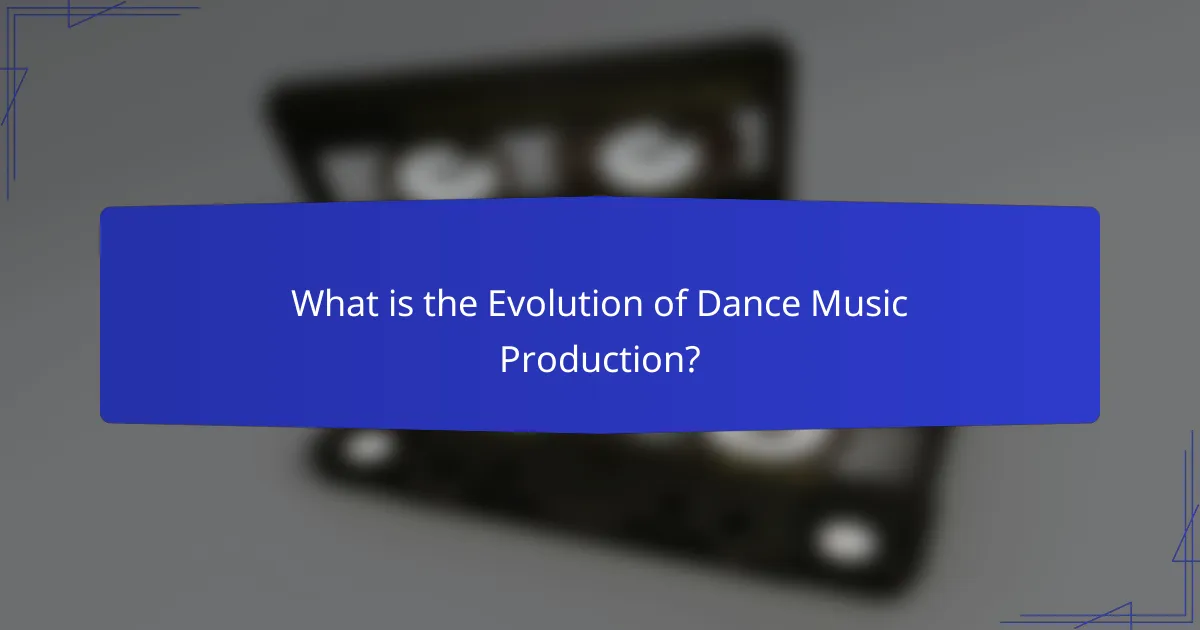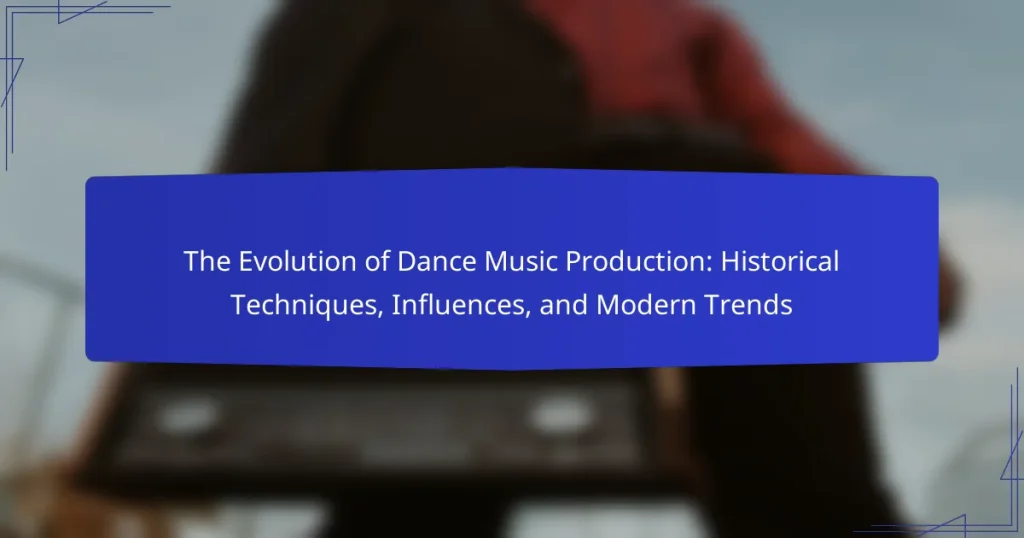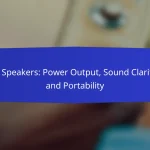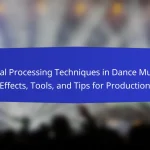The article explores the evolution of dance music production, tracing its historical development from the 1970s to the present. Early dance music, rooted in disco, utilized four-on-the-floor beats and orchestral arrangements, while the 1980s introduced electronic elements through synthesizers and drum machines, leading to the emergence of house and techno genres. The 1990s saw the rise of rave culture and advanced sampling techniques, giving way to breakbeat and trance. In the 2000s, genres like dubstep and electro house gained popularity due to accessible production software. Today, dance music production is characterized by diverse influences from hip-hop, pop, and global music, with online platforms facilitating broader artist participation in music creation and distribution.

What is the Evolution of Dance Music Production?
The evolution of dance music production has transformed significantly since its inception. Early dance music emerged in the 1970s with disco, characterized by four-on-the-floor beats and orchestral arrangements. The 1980s introduced electronic elements, with the advent of synthesizers and drum machines, leading to genres like house and techno.
In the 1990s, rave culture popularized breakbeat and trance, utilizing advanced sampling techniques and digital audio workstations. The 2000s saw the rise of genres like dubstep and electro house, influenced by the accessibility of production software.
Today, dance music production incorporates diverse influences from hip-hop, pop, and global music. The use of online platforms has democratized music creation, allowing more artists to produce and distribute their work. This evolution reflects technological advancements and changing cultural trends in the music industry.
How has dance music production changed over the decades?
Dance music production has evolved significantly over the decades. In the 1970s, disco music dominated with analog synthesizers and drum machines. The introduction of MIDI in the 1980s allowed for more complex arrangements and easier integration of electronic instruments. The 1990s saw the rise of genres like techno and house, driven by software like Cubase and Pro Tools. In the 2000s, production became more accessible with the advent of affordable digital audio workstations (DAWs) like Ableton Live. The 2010s shifted focus towards sample-based production and collaboration through cloud services. Today, AI and machine learning tools are influencing music creation, enhancing creativity and efficiency. Each decade reflects technological advancements that have reshaped the production landscape.
What were the key milestones in the history of dance music production?
The key milestones in the history of dance music production include the emergence of disco in the 1970s. This genre laid the groundwork for dance music with its four-on-the-floor beats. The introduction of synthesizers in the 1980s revolutionized sound design. Artists like Kraftwerk and Giorgio Moroder utilized technology to create new sounds. The late 1980s saw the rise of house music in Chicago, characterized by its repetitive beats and soulful vocals. The 1990s introduced techno and rave culture, which expanded the audience for electronic dance music. The advent of digital audio workstations in the late 1990s transformed production techniques, allowing for greater creativity and accessibility. The 2000s witnessed the mainstream acceptance of electronic dance music, with artists like Daft Punk and Calvin Harris achieving global success. Each of these milestones contributed to the evolution of dance music production.
How did technological advancements influence dance music production?
Technological advancements significantly influenced dance music production by introducing new tools and techniques. Digital audio workstations (DAWs) allowed producers to create, edit, and mix music more efficiently. Software synthesizers replaced traditional hardware, offering a wider range of sounds and effects. MIDI technology enabled precise control over musical elements, enhancing creativity in composition. Sampling technology facilitated the incorporation of diverse sound bites into tracks. The rise of the internet provided platforms for sharing music globally, expanding audience reach. Additionally, affordable production equipment democratized music creation, allowing more artists to enter the industry. These advancements collectively transformed dance music into a more accessible and innovative genre.
What are the foundational techniques in dance music production?
Foundational techniques in dance music production include beat-making, sampling, and arrangement. Beat-making involves creating rhythmic patterns using drum machines or software. Sampling refers to using pre-recorded sounds or music clips to build tracks. Arrangement is the process of structuring a song into sections like intro, verse, chorus, and outro. These techniques are essential for crafting dance music that resonates with audiences. Historical context shows these methods have evolved with technology, influencing genres like house and techno. Dance music production often relies on software like Ableton Live or FL Studio, which facilitate these foundational techniques.
What traditional methods were used in early dance music production?
Traditional methods used in early dance music production included live instrumentation, acoustic recording techniques, and analog synthesizers. Musicians often performed live in studios, capturing the energy of their performances. Acoustic recording involved capturing sound directly onto physical media, such as vinyl or magnetic tape. This method required precise microphone placement and sound engineering skills. Analog synthesizers were also pivotal, allowing for the creation of unique sounds and textures. These devices used voltage to generate sound waves, providing a distinct character to dance music. The combination of these methods shaped the early sound of dance music, influencing later developments in the genre.
How have sampling and looping techniques evolved in dance music?
Sampling and looping techniques in dance music have significantly evolved over the decades. Initially, sampling began with analog tape machines in the 1970s. Early pioneers like Kraftwerk used tape loops to create rhythmic patterns. The introduction of digital samplers in the 1980s, such as the Akai MPC, revolutionized sampling. This allowed producers to manipulate audio more easily and creatively.
In the 1990s, software like Ableton Live and Pro Tools further advanced looping capabilities. Producers gained access to non-linear editing and real-time manipulation. Modern techniques now include granular synthesis and complex layering of samples. These advancements enable intricate sound design and unique compositions.
Today, sampling often incorporates a wide range of genres and influences. The use of royalty-free sample libraries has also expanded accessibility for producers. As a result, sampling and looping techniques continue to shape the landscape of dance music.
What influences have shaped dance music production?
Dance music production has been shaped by various influences including technological advancements, cultural movements, and genre evolution. The introduction of synthesizers in the 1970s revolutionized sound creation. Genres such as disco and house emerged, influencing rhythm and style. The rise of electronic dance music (EDM) in the 1990s expanded its global reach. Sampling techniques from hip-hop contributed to innovative soundscapes. Collaborations between artists across genres fostered creativity. The internet and digital distribution transformed access and production methods. Festivals and clubs have played a crucial role in popularizing dance music. These factors combined have significantly impacted the landscape of dance music production.
How have cultural movements impacted dance music genres?
Cultural movements have significantly influenced dance music genres by shaping their themes, sounds, and popularity. For instance, the civil rights movement in the 1960s inspired funk and soul, which laid the groundwork for disco. Disco emerged as a celebration of freedom and diversity, reflecting the [censured] community’s struggle for acceptance. The rise of hip-hop in the 1970s and 1980s brought sampling and beat-making techniques that transformed dance music. The rave culture of the 1990s emphasized electronic dance music, promoting unity and escapism. Additionally, the feminist movement has influenced genres like house music, empowering female artists and DJs. These cultural shifts have continuously redefined dance music, making it a dynamic and evolving art form.
What role do collaborations play in the evolution of dance music?
Collaborations are crucial in the evolution of dance music. They bring together diverse influences and styles. Artists combine their unique sounds, creating innovative tracks. Collaborations often lead to genre-blending, expanding the dance music landscape. For example, the partnership between David Guetta and Sia produced chart-topping hits. These collaborations can introduce new audiences to different musical styles. They also foster community within the music industry. Collaborative projects can result in higher quality production through shared expertise. Overall, collaborations drive creativity and evolution in dance music.
What are the modern trends in dance music production?
Modern trends in dance music production include the use of advanced technology and software. Producers increasingly rely on digital audio workstations (DAWs) for music creation. Popular DAWs like Ableton Live and FL Studio dominate the scene. There is a rise in the use of virtual instruments and plugins to enhance sound quality. Collaboration across genres is becoming more common, leading to innovative sound fusions. Additionally, the integration of artificial intelligence in music composition is gaining traction. Streaming platforms are influencing production styles to cater to shorter track lengths. Finally, a focus on immersive audio experiences is emerging, with artists experimenting with spatial audio techniques.
How has the rise of digital audio workstations changed production styles?
The rise of digital audio workstations (DAWs) has significantly transformed production styles. DAWs enable producers to create, edit, and mix music entirely on computers. This shift has democratized music production, allowing more individuals access to professional tools. The flexibility of DAWs supports diverse genres and experimentation. Producers can easily manipulate audio tracks, apply effects, and arrange music in non-linear ways. The integration of MIDI technology enhances creativity in composition and arrangement. Additionally, collaboration has become more streamlined through cloud-based platforms. Studies indicate that DAWs have increased the speed of production cycles, allowing for rapid iteration and refinement. This evolution reflects a broader trend towards accessibility and innovation in music creation.
What are the current popular genres within dance music production?
The current popular genres within dance music production include house, techno, trance, and drum and bass. House music features a steady four-on-the-floor beat and often incorporates soulful vocals. Techno is known for its repetitive beats and synthesized sounds, creating an immersive experience. Trance is characterized by melodic phrases and build-ups, often leading to euphoric drops. Drum and bass combines fast breakbeats with heavy basslines, appealing to energetic audiences. According to Beatport’s charts, these genres consistently rank among the top-selling categories in electronic music.
How do contemporary artists approach dance music production?
Contemporary artists approach dance music production by integrating technology and collaborative practices. They use digital audio workstations (DAWs) to create, edit, and mix tracks efficiently. Many artists collaborate with other musicians and producers to enhance creativity. They often draw inspiration from various genres, blending elements to create unique sounds. Sampling and remixing are common techniques, allowing artists to pay homage to previous works. Live performances often incorporate real-time production techniques, engaging audiences in new ways. The use of social media platforms enables artists to share their work and gain feedback rapidly. This approach reflects the dynamic nature of the current music landscape.
What techniques are most commonly used by modern dance music producers?
Modern dance music producers commonly use techniques such as sampling, synthesizing, and beat-making. Sampling involves taking snippets of existing recordings to create new tracks. This technique allows producers to incorporate diverse sounds and styles. Synthesizing creates sounds using electronic instruments, enabling unique audio textures. Beat-making focuses on crafting rhythmic patterns that drive the track. Additionally, automation is used to control various parameters over time, enhancing dynamics. Effects processing, such as reverb and delay, adds depth to the music. Finally, mixing techniques ensure clarity and balance among different elements in the production. These techniques are foundational in contemporary dance music, shaping its sound and appeal.
How do artists incorporate live elements into their dance music productions?
Artists incorporate live elements into their dance music productions by using live instruments, vocal performances, and real-time manipulation of sounds. Live instruments such as guitars, keyboards, and drums add organic textures to electronic tracks. Vocal performances can enhance emotional depth and connect with audiences. Real-time sound manipulation through MIDI controllers and effects processors allows artists to create dynamic and evolving soundscapes.
Additionally, incorporating live looping techniques enables artists to layer sounds during performances. Collaborations with musicians can also bring unique elements into the production process. This integration of live aspects creates a more immersive experience for listeners. The blending of electronic and live components has become a defining feature in modern dance music.
What challenges do producers face in the current dance music landscape?
Producers in the current dance music landscape face several challenges. One major challenge is oversaturation in the market. There are countless tracks released daily, making it difficult for individual producers to stand out. Additionally, producers must navigate evolving technology and software. Keeping up with new tools can be overwhelming and requires constant learning.
Another challenge is the changing dynamics of music consumption. Streaming platforms dominate, which can impact revenue for producers. They often struggle to monetize their work effectively. Furthermore, competition from social media platforms increases pressure to create viral content. This shift can detract from artistic expression in favor of commercial appeal.
Lastly, producers face the challenge of collaboration in a remote environment. While technology enables remote work, it can complicate communication and creative synergy. These factors collectively create a demanding landscape for dance music producers today.
How do copyright issues affect dance music production?
Copyright issues significantly impact dance music production by restricting the use of samples and melodies. Producers must obtain licenses for any copyrighted material they wish to incorporate. Failing to do so can result in legal disputes or financial penalties. Additionally, copyright infringement can lead to the removal of tracks from streaming platforms. This legal framework encourages originality in music creation. Producers often turn to royalty-free samples to avoid copyright complications. The rise of digital distribution has made copyright enforcement more critical than ever. Overall, understanding copyright is essential for successful dance music production.
What are the common pitfalls in modern dance music production?
Common pitfalls in modern dance music production include over-compression, poor arrangement, and neglecting sound design. Over-compression can lead to a loss of dynamic range. This reduces the track’s overall impact. Poor arrangement can result in a lack of flow and coherence. A track that lacks structure may fail to engage listeners. Neglecting sound design can lead to generic sounds. Unique sounds are crucial for standing out in a crowded market. Additionally, not paying attention to mixing can cause muddiness. This makes it difficult for individual elements to shine. Lastly, ignoring feedback can hinder growth. Constructive criticism is essential for improvement.
What best practices can enhance dance music production?
Utilizing high-quality samples enhances dance music production. Quality samples provide a professional sound. Layering sounds creates depth and richness. This technique is widely used in successful tracks. Employing proper EQ techniques ensures clarity in the mix. Clear mixes allow each element to stand out. Using sidechain compression adds movement and energy. This method is a staple in dance music. Regularly referencing professional tracks helps maintain industry standards. Analyzing successful tracks provides insights into effective production techniques. Experimenting with different genres can inspire creativity. Diversifying influences leads to unique soundscapes. Finally, continuous learning and practice improve overall skills. Engaging with tutorials and communities fosters growth in production knowledge.
How can producers improve their workflow in the studio?
Producers can improve their workflow in the studio by implementing organized project management systems. This includes using templates for consistent session setups. Streamlining file organization ensures quick access to samples and presets. Utilizing efficient software tools can enhance collaboration and communication. Regularly updating software and hardware keeps systems running smoothly. Setting specific goals for each session helps maintain focus and productivity. Additionally, incorporating breaks can prevent burnout and maintain creativity. Research shows that structured workflows can lead to faster project completion and higher quality outputs.
What resources are available for learning dance music production techniques?
Online courses, tutorials, and books are available for learning dance music production techniques. Platforms like Coursera and Udemy offer structured courses on music production. YouTube hosts numerous free tutorials from experienced producers. Websites such as Splice and Skillshare provide project files and lessons. Books like “The Dance Music Manual” by Rick Snoman cover essential techniques and theory. Forums and communities, such as Gearslutz and Reddit, allow for peer learning and feedback. These resources cater to various skill levels, from beginners to advanced producers.
The main entity of this article is the evolution of dance music production. The article provides a comprehensive overview of the historical techniques, key milestones, and technological advancements that have shaped dance music from its origins in the 1970s disco era to contemporary practices. It discusses foundational techniques such as beat-making and sampling, the influence of cultural movements, and modern trends including the use of digital audio workstations and AI tools. Additionally, the article highlights challenges faced by producers today, best practices for enhancing production quality, and available resources for learning production techniques.


